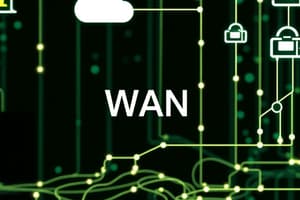Podcast
Questions and Answers
What is the Open Systems Interconnection (OSI) model?
What is the Open Systems Interconnection (OSI) model?
A conceptual framework used to understand network interactions in seven layers.
The _____ model consists of seven layers.
The _____ model consists of seven layers.
OSI
What are the characteristics of network topologies?
What are the characteristics of network topologies?
The layout or arrangement of different elements (links, nodes) in a computer network.
What types of cables are used in networking?
What types of cables are used in networking?
What is subnetting in regard to IP addressing?
What is subnetting in regard to IP addressing?
What purpose do network services serve?
What purpose do network services serve?
Name a common network device.
Name a common network device.
Which of the following are types of network cables? (Select all that apply)
Which of the following are types of network cables? (Select all that apply)
A router is used for connecting devices within a single local network.
A router is used for connecting devices within a single local network.
What is the purpose of routing technologies?
What is the purpose of routing technologies?
Flashcards
OSI Model
OSI Model
A conceptual framework that breaks down network communications into seven distinct layers, each handling specific tasks.
Network Topology
Network Topology
The physical layout of a network, showing how nodes and links are connected.
Network Cables
Network Cables
Twisted pair, coaxial, and fiber optic cables are all used for transmitting network signals.
Subnetting
Subnetting
Signup and view all the flashcards
Network Services
Network Services
Signup and view all the flashcards
Router
Router
Signup and view all the flashcards
Twisted Pair Cable
Twisted Pair Cable
Signup and view all the flashcards
Coaxial Cable
Coaxial Cable
Signup and view all the flashcards
Fiber Optic Cable
Fiber Optic Cable
Signup and view all the flashcards
Routing
Routing
Signup and view all the flashcards
Study Notes
Networking Fundamentals
- Compare and contrast the OSI model layers, emphasizing the role of encapsulation in data transmission.
- Understand different network topologies (like star, mesh, bus) and types (LAN, WAN, MAN), including their characteristics and use cases.
- Identify various types of cables (Ethernet, fiber optic, coaxial) and connectors (RJ-45, LC, SC), and choose the appropriate ones for specific networking needs.
- Ability to configure a subnet, implementing correct IP addressing schemes to manage network resources effectively.
- Explain common network ports (like HTTP on port 80, HTTPS on port 443) and protocols, including their secure alternatives (e.g., SFTP for FTP).
- Understand the purpose and function of essential network services (DNS, DHCP) in maintaining communication and resource management.
- Describe basic corporate and data center network architectures, addressing design and scalability factors.
- Remember key concepts of cloud computing, including deployment models (public, private, hybrid) and connectivity options (VPNs, direct access).
Network Implementations
- Analyze various networking devices (routers, switches, firewalls) and assess their features and optimal placement within a network.
- Compare different routing technologies (static vs. dynamic routing) and evaluate bandwidth management concepts (QoS, traffic shaping).
- Practice configuring and deploying fundamental Ethernet switching features like VLANs and port security for enhanced network performance.
- Install and configure suitable wireless standards (802.11a/b/g/n/ac/ax) to ensure effective wireless communication and performance.
Network Operations
- Apply the use of network statistics and sensors (SNMP, logs) to monitor and ensure network availability effectively.
- Understand the importance of organizational documents (network diagrams, policies) and their role in establishing guidelines and best practices.
Studying That Suits You
Use AI to generate personalized quizzes and flashcards to suit your learning preferences.




